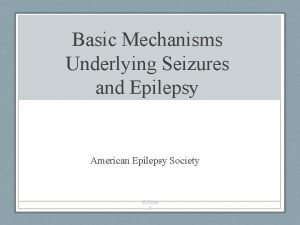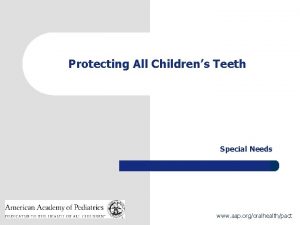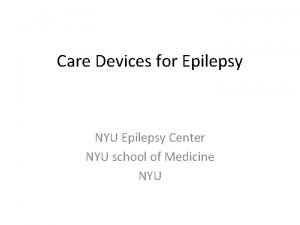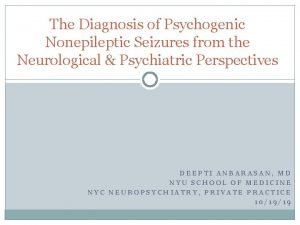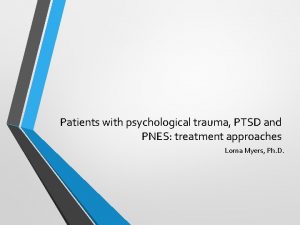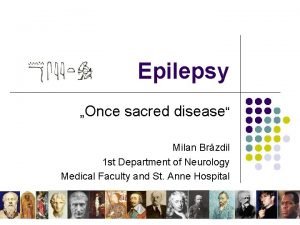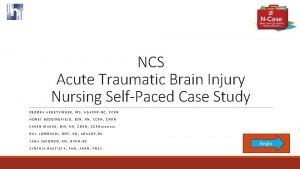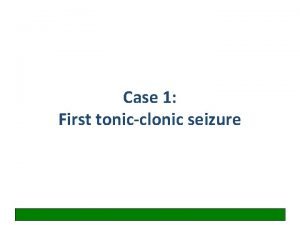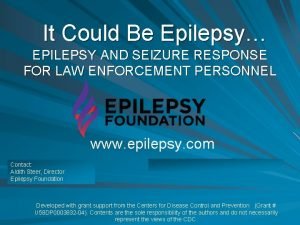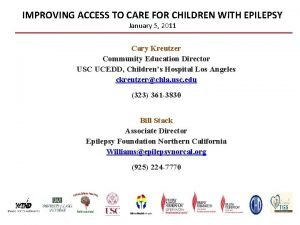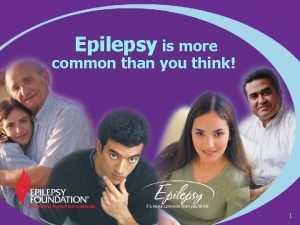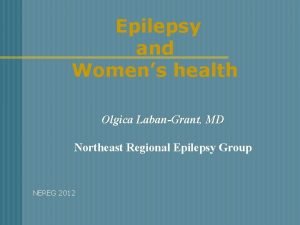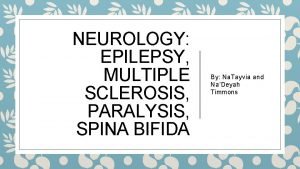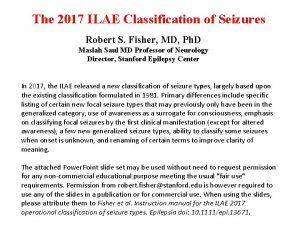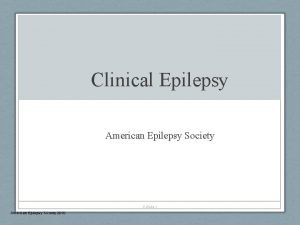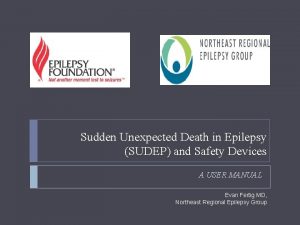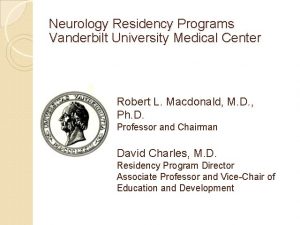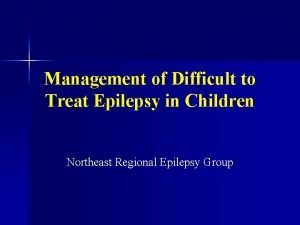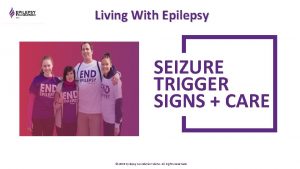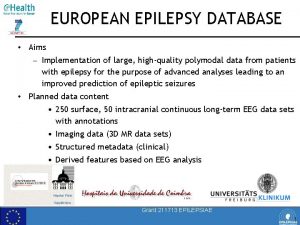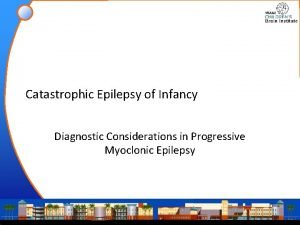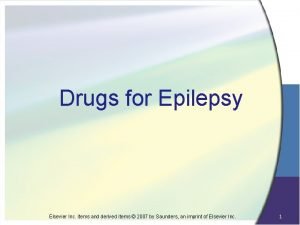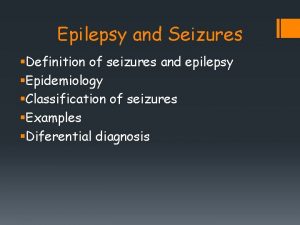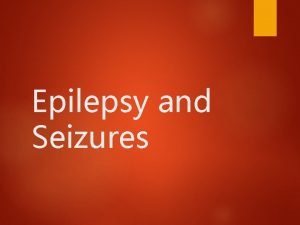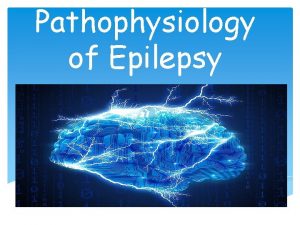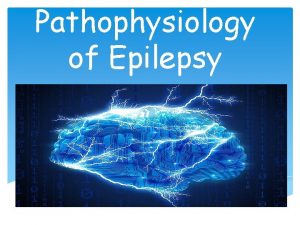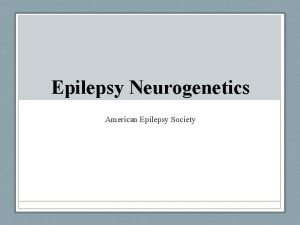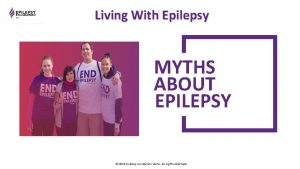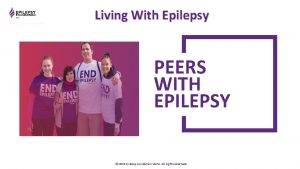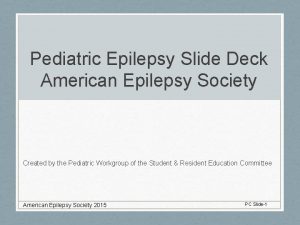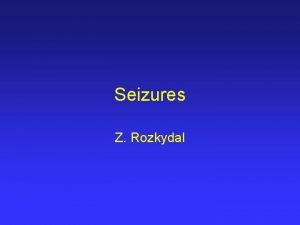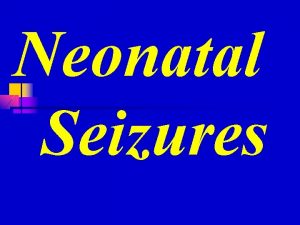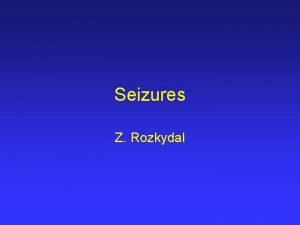PEDIATRIC EPILEPSY UPDATE ORRIN DEVINSKY MD SEIZURES AND







































- Slides: 39

PEDIATRIC EPILEPSY UPDATE ORRIN DEVINSKY, MD

SEIZURES AND EPILEPSY • A seizure is a brief, excessive discharge of brain electrical activity that changes how a person feels, senses, thinks, or behaves. • Epilepsy is a disorder in which a person has two or more seizures without a clear cause. • More than 2 million Americans have epilepsy; 9 million will have epilepsy at some time in their life. • One in 11 people will have at least one seizure in their lifetime. • Most individuals with epilepsy have normal intelligence, behavior and are seizure free on medications • 70% of children with Epilepsy will outgrow it

COMMON QUESTIONS • • • Will my child be alright? Can he/she ever lead a normal life? Can seizures ever be controlled? Can I ever leave he/she alone? Will he/she have to take medicine for the rest of their life? • What will my friends think? • Will I ever be able to ride my bike again? Play on my school team? Go to college? Drive a car?

ROUTINE MEDICAL CARE AND EPILEPSY • My child suffers from allergies? Is it safe to administer allergy medicine? • My child has a cold, are there any medications I should avoid? • Can my child receive immunizations? • My child was prescribed antibiotics, is it safe to administer with her seizure medication?

EDUCATION/SCHOOL PLACEMENT • Most children with epilepsy attend regular classes, although in some cases they need special aides to work with them. • Special education programs- instruction in regular classrooms or separate facilities for all or part of the day. • If child is not doing well in mainstreamed classroom, parents should meet with teachers to identify the problem • Comprehensive Evaluation

CAN I LET MY CHILD GO OUT AND PLAY? • • • YES!!! Can he ride a bike? Can she swim? Can he play football? Can she go to sleep away camp? Should we tell the coach he has epilepsy? • Common sense goes a long way. Each decision should be on an individualized basis. The goal should be safety and a lifestyle as normal as possible.

VIDEO GAMES AND SEIZURES • Video games do not cause epilepsy. • Children who are photosensitive, and in whom flashing lights or flickering images can trigger seizures or epilepsy waves on EEG may have seizures playing video games. This occurs in approximately 3 % of people with epilepsy, so almost all children who have epilepsy should be able to play video games without seizures.

VIDEO GAMES AND SEIZURES • Play in well lighted room • Maintain distance between the screen • Avoid playing for long periods of time • Take regular breaks • Stop the game if strange/unusual feeling develops

COPING WITH EPILEPSY • Be truthful and simple. • Reassurance • You can’t catch a seizure as if it were a cold. • Fear, Grief, Anger are all normal responses. Acceptance takes time. Acceptance means that you consider your child a normal child who happens to have seizures.

COPING WITH EPILEPSY • How do you feel about having epilepsy? • How do you think other kids react to you because you have epilepsy? • Do you understand what the doctor said to you?

BIASES IN EPILEPSY CARE: LESSONS OF BEHAVIORAL ECONOMICS • Diagnostic Bias • Law of Small Numbers • Status Quo Bias • Availability Heuristic

BIASES IN MEDICINE: KAHNEMAN & TVERSKY’S LESSONS • Loss aversion • Anchoring • Framing • What You See is All There Is

WHAT DO NBA COACHES, MOTHERS AND DOCTORS HAVE IN COMMON? • The Diagnostic Bias • 1 st round v. 2 nd round choice • Diagnosis to doctor = child to mother • Reliance on prior diagnosis • Failure to consider other disorders Convulsive syncope Nonepileptic psychogenic seizures • Failure to consider diagnostic changes

LAW OF SMALL NUMBERS • Hasty generalizations from a few examples • Initial set of data is usually biased • Scientists understand power and statistics in their discipline, but often forget it when they think outside their discipline

HUMANS ARE ANECDOTE DRIVEN • We evolved to understand individual instances very well, not statistics • A moving story about a castaway dog or sick children v. a genocide of ~800 k • Would you give more for a dog or 100 sick kids? • Rwanda v. OJ Simpson – media coverage • Vaccines cause autism (NO!)

HUMANS ARE ANECDOTE DRIVEN • Sabril (vigabatrin) can cause blindness • Felbatol (felbamate) can be deadly • People can become vegetables after spinal taps • You only need to hear about one bad case…and it doesn’t have to be true • Need to examine the evidence

FAILURE TO UNDERSTAND NUMBERS • The medical literature is very confusing, even for scientists and doctors • Few doctors and fewer patients have formal statistical training • The Monte Hall problem • AED/blood count/liver tests and Cancer Screening – America makes political not wise choices

STATUS QUO BIAS • Doctors and patients fall victim • Doctors accept previous diagnoses • Doctors advocate treatments that are ‘accepted’ but not ‘proven’ • Patients accept poorly controlled seizures and/or side effects • Patients accept ‘communal experience’ although unproven/anecdotal

WE GET USED TO WHAT WE GET USED TO • What do these all have in common? • Lottery winners • Quadriplegics • Farmers whose roosters rape chickens • People who eat mediocre blueberries • Parents of kids with Lennox-Gastaut Syndrome

ERRORS IN ASSESSING RISK • Surgery is too dangerous • Living with chronic epilepsy can be dangerous • Changing medications is too risky • Change can be risky; No change can be risky • The grass is browner on the other side • Breakthrough seizure • Living with chronic side effects has risks • We accept the negatives we think we know but fear the change to make them better

WHAT YOU SEE IS ALL THERE IS (WYSIATS) People make decisions based on limited data by using available information and ignoring information that is not available In Epilepsy: assume we understand causes of seizures when we may only have 10 -20% of the data

CARE OF THE CHILD WITH EPILEPSY: UNDERSTANDING THE MECHANISMS Treatment • Anti-epileptic Drugs • Metabolism-based Treatment (KGD) • Neuromodulation • Epilepsy Surgery Quality of Life • Co. Morbidities • Cognitive • Behavioral

CO-MORBIDITY DEFINITIONS AND CONCEPTS • Co-morbidity refers to the cooccurrence of two supposedly separate conditions that occur together more than chance. • Depression occurs more frequently in patients with epilepsy than in the normal population, thus epilepsy and depression are co-morbidities.

CO-MORBIDITY DEFINITIONS AND CONCEPTS • Co-morbidities may be related to the epilepsy or treatment, e. g. : • Frequent absence seizures may result in attention deficit • Headaches can occur following seizures • Cognitive impairment may be related to epileptiform discharges/seizures • AED-induced agitation, ADHD, suicidality

CO-MORBIDITY DEFINITIONS AND CONCEPTS • Co-morbidities are not necessarily causal. • Both conditions may have a common biological substrate • An independent variable triggers one of the co-morbidities • Phenobarbital triggers depression • Gabapentin triggers agitation • Co-morbidities often precede onset of the epilepsy

BEHAVIOR PROBLEMS IN CHILDREN WITH EPILEPSY: AUSTIN 2002 • Major risk factors for behavior problems in pediatric epilepsy: • neurological dysfunction • seizure variables • family environment • side effects of AEDs • Children with new-onset seizures (rank order of total behavior problems): • recurrent seizures > single seizure > sibling • Raises possibilities that both are caused by an • underlying neurological disorder.

BEHAVIORAL PROBLEMS IN NEW-ONSET EPILEPSY: AUSTIN 2002 • Evaluated 224 children with new-onset seizures (aged 414 years) and 159 siblings (4 -18 years). • During the 2 -year evaluation period, 163 (73%) children had at least one additional seizure, and 61 (27%) had none. • Children had more behavioral problems when experiencing recurrent seizures than when not experiencing recurrent seizures. • Siblings had significantly lower behavioral problems than both children experiencing and not experiencing recurrent seizures.

PRACTICE TOOLS FOR COGNITIVE AND BEHAVIORAL EFFECTS OF EPILEPSY (AES) • Cognitive (neuropsychological) well being: Children with epilepsy are at an increased risk for cognitive and behavioral impairment. Consider referral for neuropsychological evaluation for children/adolescents with epilepsy who are experiencing difficulty at home or in school. In particular, children are at risk of neuropsychological deficits who present with two or more of the following: • • • epileptiform activity on EEG regression in academic abilities or motor function abnormality on MRI (or symptomatic epilepsy syndrome) absence seizures use of antiepileptic medications undercontrolled (pharmacoresistent) seizures

EPILEPSY AND COMMON COMORBIDITIES: IMPROVING THE OUTPATIENT ENCOUNTER • Screen for adverse AED effects • • • Assess physical fitness, activity Review sleep hygiene Screen for mood disorders (depression, anxiety) Screen for educational functioning Screen for behavior problems Assess other family, patient concerns

RELATIONSHIP BETWEEN SEIZURES & COGNITIVE DYSFUNCTION Brain Injury ? y r u nj I y ar d n o Sec Seizures and EEG anormalities Cognitive Impairment

RESCUE MEDICATIONS OR NO IV ACCESS • Midazolam: nasal, buccal, IM • Diazepam: rectal, buccal • Clonazepam: oral, dissolvable

METABOLISM-BASED TREATMENTS (KETOGENIC DIET): FOUR VERSIONS Four Versions 1) Classic ketogenic diet 2) MCT ketogenic diet can’t do 3/1 ratio, usually g-tube fed 3) Low glycemic index treatment 4) Modified Atkins/ modified ketogenic diet Certain Syndromes • Myoclonic-Atonic Epilepsy (Doose Syndrome) • Severe Myoclonic Epilepsy of Infancy (Dravet Syndrome) • Infantile Spasms • Tuberous Sclerosis • Rett Syndrome • Pyruvate dehydrogenase Deficiency • Glucose Transporter Defect

WHEN TO REFER FOR EPILEPSY SURGERY • Medically Refractory Epilepsy • Children • Uncontrolled by medical therapy • Failure two or three AEDs • Disabling seizures, side effects • MRI reveals surgical lesion (epileptogenic lesion) • Criteria and Referral for evaluation of pediatric epilepsy surgery; ILAE Epilepsia 2006; 47: 952 -959.

NEUROMODULATION • Vagus Nerve Stimulation • Deep Brain Stimulation (anterior thalamic nucleus) • Responsive Neurostimulation (Neuro. Pace) • Transcranial Magnetic Stimulation

THE RNS™ SYSTEM • Cranially implanted battery powered responsive neurostimulator • Connected to 2 leads (depth and/or subdural) with 4 electrode contacts each

Figure 3 The Neuro. Pace Responsive Neurostimulator (RNS®) System (Mountain View, CA) Stacey WC and Litt B (2008) Technology Insight: neuroengineering and epilepsy— designing devices for seizure control Nat Clin Pract Neurol 10. 1038/ncpneuro 0750

THE RNS® SYSTEM: RESPONSIVE STIMULATION Neurostimulator and Leads Remote Monitor Programmer Patient Data Management System (PDMS)

RNS® SYSTEM: RESPONSIVE STIMULATION • Physician identifies electrocortico-graphic activity to be detected • Detection and stimulation settings programmed, then adjusted as needed • Varied seizure patterns require individualized settings

THE NEUROPACE RESPONSIVE NEUROSTIMULATOR (RNS®) SYSTEM TRIAL RESULTS 191 subjects implanted and randomized 1 month after implant to active v. sham 38% Seizure Reduction in Active Treatment 17% Seizure Reduction in Sham Treatment Open Label followup seizure reduction 44% 1 year 53% 2 years Heck et al, Epilepsia, 2014
 Orrin devinsky md
Orrin devinsky md Basic mechanisms underlying seizures and epilepsy
Basic mechanisms underlying seizures and epilepsy Pediatric seizures
Pediatric seizures Orrin broberg
Orrin broberg Orrin franko
Orrin franko Nyu epilepsy center phone number
Nyu epilepsy center phone number Recovery techniques based on immediate update
Recovery techniques based on immediate update Tremors and seizures
Tremors and seizures Non epileptic seizures
Non epileptic seizures Lorna myers pnes
Lorna myers pnes Psychomotor seizures
Psychomotor seizures Psychomotor seizures
Psychomotor seizures Icp monitoring
Icp monitoring Spina bifida occulta
Spina bifida occulta Seizures
Seizures Tonic-clonic seizures
Tonic-clonic seizures Shaking vs seizure
Shaking vs seizure Seizures
Seizures Complex febrile
Complex febrile Simple partial seizures vs complex
Simple partial seizures vs complex Simple partial seizures vs complex
Simple partial seizures vs complex Epilepsy
Epilepsy Difference between seizure and epilepsy
Difference between seizure and epilepsy Catamenial epilepsy and birth control pills
Catamenial epilepsy and birth control pills Spina bifida and epilepsy
Spina bifida and epilepsy Food product knowledge
Food product knowledge Seizure types and symptoms
Seizure types and symptoms Canadian league against epilepsy
Canadian league against epilepsy Syncope vs seizure
Syncope vs seizure Aremco epilepsy
Aremco epilepsy Vanderbilt neurology residents
Vanderbilt neurology residents Benign rolandic epilepsy rch
Benign rolandic epilepsy rch Seizure triggers
Seizure triggers European epilepsy database
European epilepsy database Catastrophic epilepsy infancy
Catastrophic epilepsy infancy Post ictal meaning
Post ictal meaning Cps epilepsy
Cps epilepsy Epilepsy foundation eau claire wi
Epilepsy foundation eau claire wi Epilepsy
Epilepsy Lamictal memory loss
Lamictal memory loss

